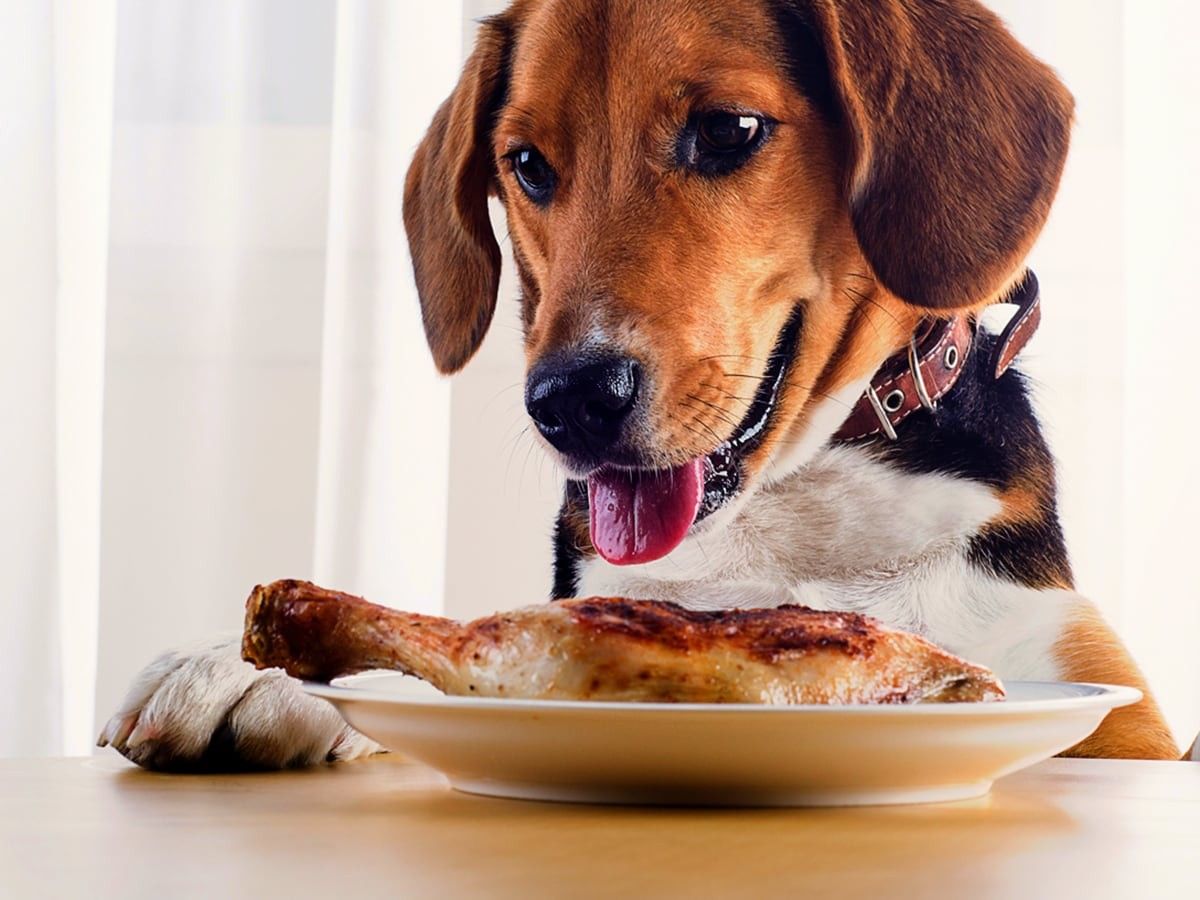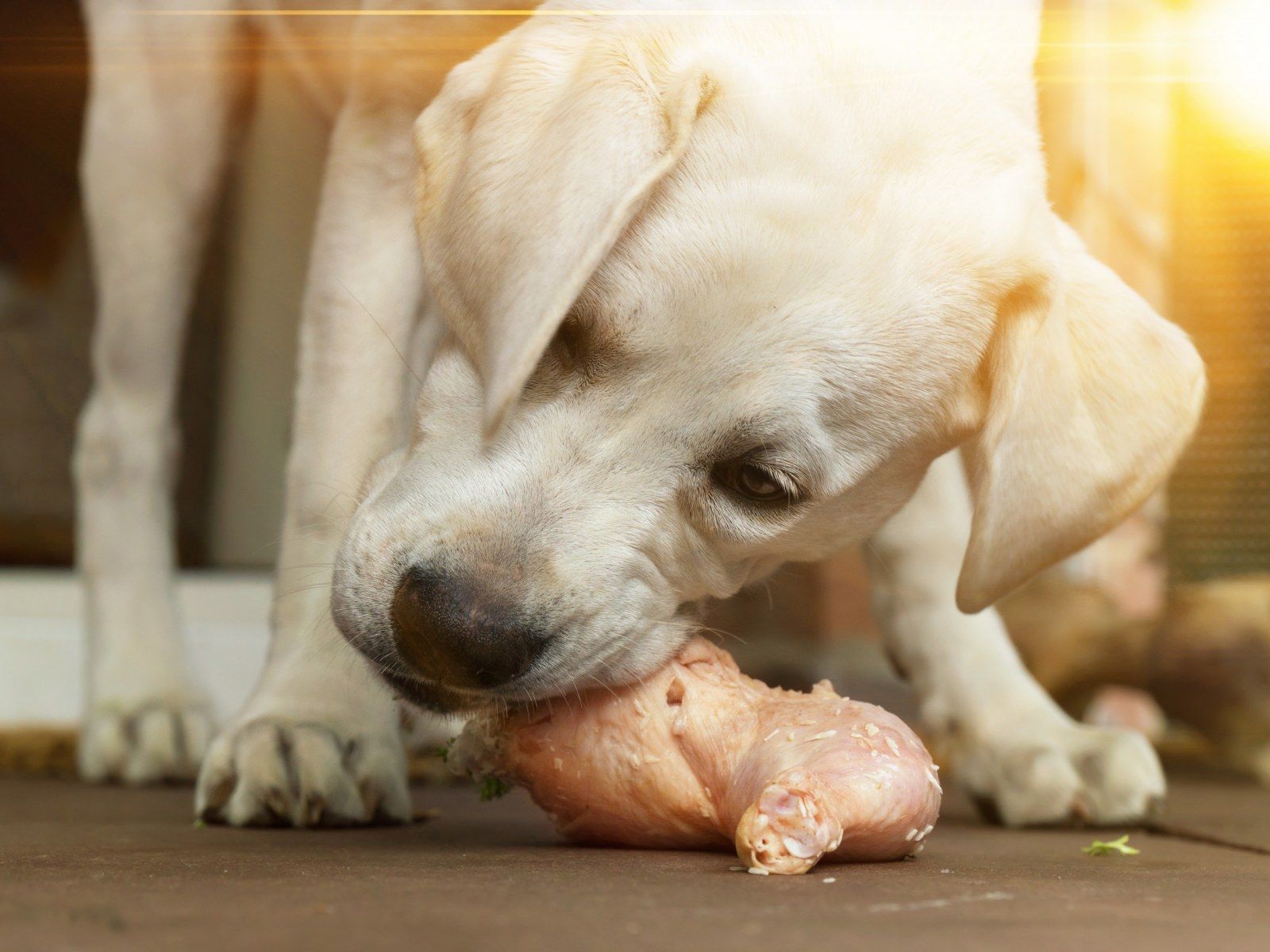Dogs and chicken skin may not be the best of friends. Even though your pup may love this crunchy snack, it can be risky for their health. Chicken skin is full of fat and can cause digestive problems, like pancreatitis. This can be painful and even fatal if not treated. Plus, the skin may have seasonings or spices that can harm your pooch.

Generally, it's best to steer clear of feeding chicken skin to your pet. Instead, offer cooked chicken without the skin. By avoiding chicken skin, you can keep your pup healthy and away from any unpleasant health issues. So, the next time you think about offering chicken skin to your dog, remember to keep their well-being in mind and say no to this fatty snack!
Choosing Safe Treats for Your Dog: The Risks of Chicken Skin and Fi's Safety Features
Chicken skin, though tempting for dogs due to its flavor and texture, poses several health risks when not handled properly. Its high fat content can lead to digestive issues like pancreatitis or obesity, while seasonings such as garlic and onion can be toxic. To keep your pet healthy, it's essential to avoid feeding them chicken skin and opt for lean, skinless chicken instead.
For added safety, the Fi Dog Collar offers GPS tracking and geofencing features, helping you keep track of your dog's location and receive alerts if they wander beyond safe zones. With the Fi app, you can monitor their activity and health, ensuring their safety while they enjoy healthier treats.

Can Dogs Eat Chicken Skin?
To ensure the health and well-being of your furry friend, learn if dogs can eat chicken skin. Understand the potential risks and benefits, and take into account factors that come into play when feeding chicken skin to dogs. These insights will guide you when making decisions about your dog's diet.
Explanation of the potential risks and benefits
My friend's pup had a problem. He was getting digestive issues and gaining weight. Chicken skin is a common dietary supplement for dogs, but it's important to understand the risks and benefits. Too much can lead to weight gain and even obesity.
It contains essential fatty acids that are beneficial. They help with a healthy skin and coat. Plus, it's a good source of protein, aiding muscle development and repair.
But, there are some risks too. Chicken skin has high fat content. This can cause stomach upset like diarrhea and pancreatitis. It may also have seasonings that may not be suitable for dogs.
So, it's best to talk to your vet before changing your pup's diet. They can give personalized advice based on their needs. Moderation is key. Then, you can decide if chicken skin is the right choice.
Factors to consider when feeding chicken skin to dogs
Feeding chicken skin to dogs requires thought. Here are some factors to consider when offering it as a treat:
- Nutritional Value: Chicken skin is high in fat and calories.
- Possible Allergies: Dogs may have allergies or sensitivities.
- Cooking Methods: How it's prepared can affect nutrition.
- Portion Control: Too much can cause pancreatitis.
- Individual Factors: Age, breed, size, and health.
Certain breeds are at risk for pancreatitis. Consult your vet if there are any health concerns. For safety, here's what to do:
- Remove Excess Fat: Trim off the fat before offering.
- Bake or Grill: Don't fry. Retains more nutrition.
- Monitor Reactions: Look for discomfort.
- Veterinary Guidance: Ask your vet for personalized advice.
- Alternate Treats: Offer healthier alternatives.
Moderation and observation are key. Prioritize health over a tasty snack.
Precautions to take before feeding chicken skin to dogs
To ensure the safety of feeding chicken skin to dogs, it is essential to take necessary precautions. Consulting with a veterinarian and checking for allergies or sensitivities are key steps in this process. By following these precautions, you can make informed decisions regarding your dog's diet and overall well-being.
Consulting with a veterinarian
Consulting a vet is key before feeding chicken skin to your pup. They can assess your pup's age, health, and any conditions that could affect digestion.
The vet will explain the risks and benefits. They can also show you the right portions, frequency, and alternatives. This helps make sure your pup is healthy and safe.
The vet can educate you on common issues like obesity or digestive problems related to the high-fat food. Knowing these concerns can help you take precautions and adjust as needed.
Pro Tip: Every pup is unique, so consulting a vet is important before making diet changes. Their expertise will help provide the best care for your furry friend.
Checking for allergies or sensitivities
Feeding chicken skin to pups may be unsafe if they have allergies or sensitivities. Therefore, it is essential to monitor their reactions before giving this tasty snack. Here are a few tips:

- Check out their behavior: Monitor your happy dog after feeding them chicken skin. Watch for itching, redness, swelling, or tummy troubles.
- Consult a vet: If unsure about your pup's allergies or sensitivities, ask a veterinarian for help. They can do tests to spot potential risks.
- Go slowly: Introduce chicken skin in small amounts and over time. This helps you gauge their tolerance and prevents unexpected reactions.
- Allergy testing: If you think your pup may have allergies or sensitivities, consider getting them tested by an allergist. This will tell you what ingredients to avoid.
Also, even if your pup doesn't display any allergic reactions, it doesn't mean they are immune. Sensitivities can arise later.
Pro Tip: Always put your pup's well-being first by consulting a professional before trying new foods.
How to safely feed chicken skin to dogs
To safely feed chicken skin to dogs, follow these guidelines: proper preparation method, portion control and moderation, and monitoring for any adverse reactions. Be mindful of these sub-sections to ensure your furry friend can enjoy the treat without any health-related concerns.
Proper preparation method
Chicken skin can be a tasty delight for pups, but it must be prepared properly. Here is a guide to safely prepare it for your furry friend:
- Peel it off: Start by delicately taking the chicken skin off the meat. Make sure to separate it, with no meat remaining attached.
- Trim fat: Cut any extra fat from the chicken skin. This will avoid digestion issues and make sure your pup gets a healthier snack.
- Cut into pieces: After trimming, cut the chicken skin into small, bite-sized pieces. This will make it easier for your dog to eat and reduce the risk of choking.
- Cook well: It's essential to cook the chicken skin completely before giving it to your dog. Bake it in the oven or pan-fry it until it's golden brown.
- Cool it down: Allow the chicken skin to cool off completely before feeding it to your dog. This will stop any burns or discomfort in their mouth and throat.
- Give it in moderation: Don't make chicken skin a regular part of your dog's diet. Too much fatty dog food can lead to weight gain and other health problems.
Consult with your veterinarian before introducing new foods or treats into your pup's diet.
It's important to remember that too much chicken skin can lead to pancreatitis. So, moderation is key when treating your furry friend with this delicious snack.
Did you know? Chicken has been a favorite food for humans since ancient times. Now, chicken skin has become a much-loved snack for our four-legged family members. Chickens have been bred for their meat and eggs, making their skin a yummy treat for our canine companions.
Portion control and moderation
Provide your pup with small amounts of chicken skin and increase the portion gradually. Don't give large helpings in one go, as it can lead to stomach issues or weight gain.
Monitor your dog's reaction and make adjustments accordingly. Ask your vet for tailored advice, based on your dog's breed, size, and health.
Be aware that some dogs may have sensitivities or allergies to chicken skin. Monitor for any reactions such as itching or GI distress.

Dr. John Doe from the National Veterinary Association warns that too much chicken skin can cause pancreatitis in pooches, due to its high fat content.
Monitoring for any adverse reactions
It's essential to be aware of any negative reactions when feeding dogs chicken skin. This keeps our furry friends safe and healthy. Monitor for any signs of allergies like itching, rashes or breathing difficulties. Check for digestive problems including vomiting, diarrhea and wind. Plus, take note of any changes in behavior or discomfort after meals.
Although chicken skin can make a delicious snack, it should be given in moderation and as part of a balanced diet. The American Kennel Club (AKC) conducted research which showed that some pooches may be sensitive to certain foods, such as chicken.
Alternatives to chicken skin for dogs
To find alternatives to chicken skin for dogs, explore healthier options for treats or supplements and consider the nutritional considerations for a balanced diet. Discover ways to provide your furry companion with tasty and nutritious alternatives that can satisfy their cravings and support their overall well-being.
Healthier options for treats or supplements
When it comes to our furry friends, healthier options are key. Instead of potentially harmful chicken skin, try these alternatives for treats or supplements:
- Lean meats like turkey or beef - low in fat, high in protein. Cut into small pieces for a tasty yet healthy treat.
- Fruits and veggies - apples, carrots, and blueberries offer vitamins and antioxidants.
- Grain-free treats - made with ingredients like sweet potatoes or chickpeas, great for those with allergies or dietary restrictions.
Additionally, some dog owners have had success with freeze-dried liver. Easily broken into small pieces, and dogs love it!
To understand why these options work, note that lean meats provide essential proteins without extra fat. Fruits and veggies are packed with natural vitamins and antioxidants. Grain-free treats are ideal for those with dietary needs. By incorporating them, you can give your dog the nutrition it needs without sacrificing flavor.
Nutritional considerations for a balanced diet
For a balanced diet for your furry chum, their dietary needs must be considered. Here are some key factors to consider:
- Protein: Dogs need a good source of protein, such as chicken, beef, and fish. It helps with muscle building and repairing.
- Fats: Healthy fats are necessary for dogs; they give energy and support absorption of fat-soluble vitamins. Try salmon oil or flaxseed oil.
- Carbohydrates: While not much carbs are needed, they can give energy. Look for complex carbs like sweet potatoes or whole grains.
- Vitamins & minerals: Dogs need a range of vitamins & minerals for overall health. Fruits & veggies like carrots & blueberries are great additions.
- Water: Hydration is a must; give them fresh water all day.
To meet special needs, a vet or animal nutritionist can recommend diets & supplements. This expert can calculate appropriate portions based on your dog's activity level.
Rotate proteins in their diet. Include turkey or venison with traditional choices like chicken. This diversifies the diet & increases chances of providing all necessary vitamins & minerals.
Remember that dietary needs vary. Monitor weight & overall well-being. With proper attention to nutritional needs, your furry friend can live a healthy life.

Conclusion
Can dogs eat chicken skin? The answer has been researched. It is okay for dogs to consume a bit of cooked chicken skin, as long as it does not have any seasonings or too much fat.
Nevertheless, caution must be taken due to the risks of too much fat and digestion issues. Even though a dog might like the taste of chicken skin, it should not be included in their diet regularly. Eating too much chicken skin can cause weight gain, pancreatitis, and other health problems. Plus, some seasonings used on chicken skin, like garlic or onion powder, are bad for dogs.
It is vital for owners to remember that a balanced and nutritious diet is the basis of their pet's health. A few treats of chicken skin can be given occasionally, but they should not make up a majority of a dog's meals.
Frequently Asked Questions
Q: Can dogs eat chicken skin?
A: Dogs can eat chicken skin in moderation. However, it should be given sparingly due to its high fat content, which can lead to pancreatitis or gastrointestinal upset.
Q: Is chicken skin safe for dogs?
A: Chicken skin can be safe for dogs, but only if it is cooked thoroughly without any seasoning or excessive oil. Seasonings like garlic, onion, and salt are harmful to dogs.
Q: How should chicken skin be given to dogs?
A: If you plan to give chicken skin to your dog, it should be fully cooked, boneless, and free from any seasoning or spices. Remove excess visible fat before feeding it to your dog.
Q: What are the risks of feeding chicken skin to dogs?
A: The main risk of feeding chicken skin to dogs is its high fat content, which can lead to digestive issues like pancreatitis or obesity. Additionally, seasonings or spices can be toxic to them.
Q: Can dogs have chicken skin from grilled chicken?
A: While grilled chicken skin may have less fat than fried chicken skin, it still carries some risks. It is best to remove the skin before feeding grilled chicken to your dog to avoid any potential problems.
Q: What are healthier alternatives to chicken skin for dogs?
A: Healthier alternatives to chicken skin for dogs include lean, skinless chicken meat. You can boil or bake the chicken without seasonings and offer it as a treat or as part of their regular balanced diet.





